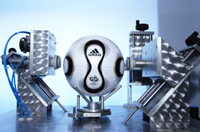|
The ball is (even) rounder
Adidas is the leading international brand in the soccer market, and not by chance. Since 1970, Adidas has been developing the new official soccer ball of the Mondial games every four years - the soccer world cup. Before Adidas embarked upon this enterprise, the soccer ball was heavy, brown, and bulky. The innovations that Adidas introduced over the years were design oriented and functional, and changed the sport unrecognizably.
The 1970 (Mexico) ball was made
entirely of leather like its predecessors, but was sewn
from five black pentagons and twenty white hexagons,
which gave it a more attractive design and a rounder
surface area (that made it possible to kick it further
and more accurately). In 1974 (Germany) the ball's
colors were changed, and in 1978 (Argentina) it was sewn
from 20 panels with groups of three, making it seem as
if it were made of 12 identical circles, and it was more
durable to weather. In 1982 (Spain) a waterproof coating
was added to the ball (and since then the ball is not as
heavy when it rains).
In 1986 (Mexico once again) a
soccer ball from synthetic leather was introduced for
the first time (more durable and absorbs less moisture).
In 1990 (Italy) an internal polyurethane layer was
added, and for the first time the ball was completely
water resistant, and faster than ever. In 1994 (United
States) the polyurethane layer was improved and it made
the ball springier (softer to the touch, easier to
control, and much faster when kicked). In 1998 (France)
a soccer ball made of three colors was introduced for
the first time, and small gas bubbles trapped in the
internal layer improved the ball's durability and
precision. In 2002 (Japan/Korea) a change in the
segments the ball was sewn from and the addition of
layers increased the ball's precision while airborne.
The 2006 Finals' ball (Germany,
this month) will reach the shelves on the 10th of
December of this year, and is expected to be the best
sold ball in history. It contains 14 parts with an
innovative design, whose sewing together decreased the
number of stitches by 15% and the quantity of points
where 3 parts touch each other by 60%. The result is a
ball that is rounder than ever before, smooth, and
easier to control. In addition, the parts are joined by
an innovative technology that uses warm adhesion, and
therefore the ball absorbs less than 0.1% water
(compared to the FIFA standard that permits 10%
absorption). A dry soccer ball flies even faster and
higher through the air.
Additional tests, conducted
with typical German precision show that the new soccer
ball is even more accurate by 30% compared to other
esteemed balls (when the ones kicking are… robots), its
diameters (which are measured in 10 different spots)
differ only by a quarter of a centimeter (in contrast to
the standard - a whole centimeter), the weight of the
new balls differ only by 3 grams (when the permitted
standard is 25 grams), and the difference between the
ball's various bounces when it is tossed from a height
of 2 meters is only up to 2 cm (the permitted standard
is 10 cm). Without a doubt this is the best soccer ball
that has ever been manufactured: it's faster, rounder,
more precise, and easier to control. Maybe this is why
the Brazilians have lost their relative advantage?
|

